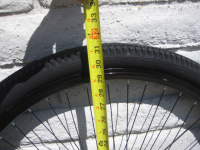With such a big front wheel surely toe-overlap must suck unless the geometry were greatly changed to put the wheel way forward no?
Yes, for any given crank length there must be some type of adjustment or compensation made to prevent a person's toe from hitting the front tire during a turn when the pedal on the opposite side of the turn happens to be in the 3 o'clock position.
Some options from a design standpoint:
1. Slacken head tube angle while simultaneously increasing fork offset. (This moves front tire forward from Bottom Bracket while keeping the trail constant..... just remember that increasing tire diameter increases trail independently. Therefore fork offset should be increased more than the head tube angle slackened if the plan is to keep trail the same as it was with a smaller diameter tire)
2. Increase top tube length while simultaneously decreasing stem length and/or decrease handlebar reach (e g. Handlebars with a greater sweep so distance to grips is decreased). This basically pushes the BB back X distance and therefore reduces toe overlap without making the handlebars harder to grab. The riding position obviously will be more upright when taking this route.
3. Some combination of #1 and #2 together. Remember trail increases with increase in tire diameter so even if route #2 is taken some increase in fork offset will have to also happen to counter the increase in trail from the larger diameter tire. That or a steepening of head tube angle. Obviously if steepening head tube angle is chosen the top tube would have to be increased even more than it would have with the increased fork offset approach.
Personally I like the idea of reducing crank length to also help the problem. This for at least two reasons:
1. Lower BB height (which is possible with a shorter length crank) increases distance of foot to tire when it is at the 3 o'clock position independently of the decrease in crank length which also increases the distance to the tire. This because the lower the BB is the farther down the curve of the tire the pedal will be when it is at 3 o'clock.
2. If using a higher RPM mid drive like the BBSHD (and wanting to pedal along with the motor) less detuning of the motor needs to happen for any given foot pedal speed (Reason: shorter crank length arms making higher RPMs easier because each revolution of the cranks is a smaller circle than it was before).

 endless-sphere.com
endless-sphere.com

 endless-sphere.com
endless-sphere.com















